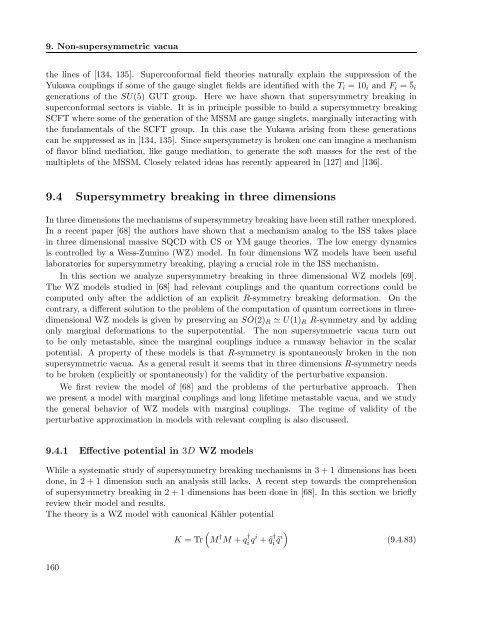Perturbative and non-perturbative infrared behavior of ...
Perturbative and non-perturbative infrared behavior of ...
Perturbative and non-perturbative infrared behavior of ...
Create successful ePaper yourself
Turn your PDF publications into a flip-book with our unique Google optimized e-Paper software.
9. Non-supersymmetric vacua<br />
the lines <strong>of</strong> [134, 135]. Superconformal field theories naturally explain the suppression <strong>of</strong> the<br />
Yukawa couplings if some <strong>of</strong> the gauge singlet fields are identified with the Ti = 10i <strong>and</strong> Fi = ¯5i<br />
generations <strong>of</strong> the SU(5) GUT group. Here we have shown that supersymmetry breaking in<br />
superconformal sectors is viable. It is in principle possible to build a supersymmetry breaking<br />
SCFT where some <strong>of</strong> the generation <strong>of</strong> the MSSM are gauge singlets, marginally interacting with<br />
the fundamentals <strong>of</strong> the SCFT group. In this case the Yukawa arising from these generations<br />
can be suppressed as in [134, 135]. Since supersymmetry is broken one can imagine a mechanism<br />
<strong>of</strong> flavor blind mediation, like gauge mediation, to generate the s<strong>of</strong>t masses for the rest <strong>of</strong> the<br />
multiplets <strong>of</strong> the MSSM. Closely related ideas has recently appeared in [127] <strong>and</strong> [136].<br />
9.4 Supersymmetry breaking in three dimensions<br />
In three dimensions the mechanisms <strong>of</strong> supersymmetry breaking have been still rather unexplored.<br />
In a recent paper [68] the authors have shown that a mechanism analog to the ISS takes place<br />
in three dimensional massive SQCD with CS or YM gauge theories. The low energy dynamics<br />
is controlled by a Wess-Zumino (WZ) model. In four dimensions WZ models have been useful<br />
laboratories for supersymmetry breaking, playing a crucial role in the ISS mechanism.<br />
In this section we analyze supersymmetry breaking in three dimensional WZ models [69].<br />
The WZ models studied in [68] had relevant couplings <strong>and</strong> the quantum corrections could be<br />
computed only after the addiction <strong>of</strong> an explicit R-symmetry breaking deformation. On the<br />
contrary, a different solution to the problem <strong>of</strong> the computation <strong>of</strong> quantum corrections in threedimensional<br />
WZ models is given by preserving an SO(2)R ≃ U(1)R R-symmetry <strong>and</strong> by adding<br />
only marginal deformations to the superpotential. The <strong>non</strong> supersymmetric vacua turn out<br />
to be only metastable, since the marginal couplings induce a runaway <strong>behavior</strong> in the scalar<br />
potential. A property <strong>of</strong> these models is that R-symmetry is spontaneously broken in the <strong>non</strong><br />
supersymmetric vacua. As a general result it seems that in three dimensions R-symmetry needs<br />
to be broken (explicitly or spontaneously) for the validity <strong>of</strong> the <strong>perturbative</strong> expansion.<br />
We first review the model <strong>of</strong> [68] <strong>and</strong> the problems <strong>of</strong> the <strong>perturbative</strong> approach. Then<br />
we present a model with marginal couplings <strong>and</strong> long lifetime metastable vacua, <strong>and</strong> we study<br />
the general <strong>behavior</strong> <strong>of</strong> WZ models with marginal couplings. The regime <strong>of</strong> validity <strong>of</strong> the<br />
<strong>perturbative</strong> approximation in models with relevant coupling is also discussed.<br />
9.4.1 Effective potential in 3D WZ models<br />
While a systematic study <strong>of</strong> supersymmetry breaking mechanisms in 3 + 1 dimensions has been<br />
done, in 2 + 1 dimension such an analysis still lacks. A recent step towards the comprehension<br />
<strong>of</strong> supersymmetry breaking in 2 + 1 dimensions has been done in [68]. In this section we briefly<br />
review their model <strong>and</strong> results.<br />
The theory is a WZ model with ca<strong>non</strong>ical Kähler potential<br />
160<br />
<br />
K = Tr M † M + q †<br />
iqi + ˜q †<br />
i ˜qi<br />
(9.4.83)
















